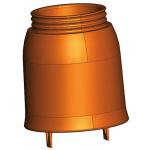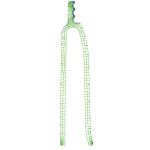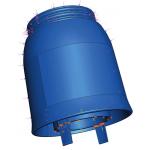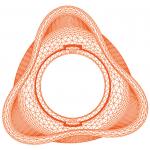Latest News
February 1, 2007
By Pradipta Moulik
Firestone Industrial Products Company, based in Indianapolis, IN, is one of the world’s foremost manufacturers of air suspension technology for the transportation industry. Since 1938, when we patented the first rubber air spring, our company has continued to engineer innovative air spring systems forautomotive, trucking, off-road, and rail applications.
Figure 1: Firestone Industrial Products makes airspring systems for the transportation industry, such as this system forautomotive applications.
We rely on a sophisticated array of test equipment and FEA tools to support the design of new air springs. In a recent project, our ABAQUS simulation software helped us understand why an automotive air spring piston failed during prototype testing after very low fatiguecycles.
Puzzling Problems
In automobiles, air springs improve ride and handling by providing a cushion of air between the wheels and the vehicle frame. The spring basically consists of an air-filled rubber cord structure that rolls up and down over a plastic or steel piston (see Figure 1, above). As the vehicle travels over the roadway, the spring undergoes jounce and rebound motion, absorbing energy from thewheels.
Figure 2: During development of an automotive air spring prototype, physical tests showed deformation after very low fatigue cycles.Note the cracked piston at right. The material is glass-filled nylon.
To meet new customer requirements, Firestone engineers had made as light modification to a prototype air spring piston profile, built a prototype, and submitted it for testing. As Figure 2 (above) shows,the prototypebuckled and cracked. The failure was unexpected, as we had thoroughly analyzed aprior design that was very similar, and the stresses were within limits. With a cracked prototype in hand, we had to get to the bottom of the problem.
Figure 3: Two views of the prototype piston design.Firestone engineers used ABAQUS software to analyze the prototype and determine why it failed during testing.
Using ABAQUS, I performed a 2D axisymmetric analysis of thepiston profile (see Figures 3 above and 4 below). At operating loads, the results showed some minor stress around the lip of the piston where it fastens to the rubber cord structure. These stress results mirrored those we had obtained for the prior design and suggested that the piston should have performed correctly. I decided to perform a 3D analysis to further investigate thefailure.
Figure 4: The first step in analysis was to model the piston in 2D axisymmetric profile.The blue arrows (left) show where loads were applied to the 2D meshed model. The analysis results (right) show only minor stress around the top lip of the piston. Based on the 2D contour plot, itappeared that the piston would withstand operational loads.
As Figure 5 (below) shows, the 3D analysis results alsoindicated stress around the top lip of the piston only. The stress contour plotdid not predict anything close to the distortion we observed in the prototypetest, and the analysis ran to completion without a hitch. The questionremained.Why did the piston buckle in the test?
Causes Revealed
The answer to the question lay in special diagnostics generated by ABAQUS while it runs. When I checked these diagnostics, the evidence of buckling was clear. Several warning notices highlighted in red indicated that the system matrix had four negative eigen values and that a buckling load may have been exceeded. ABAQUS contains these specialized diagnostic messages specifically to help engineers conduct complex analyses, such as those required for air spring design.
Figure 5: To further investigate the piston failure, Firestone performed a 3D analysis. The analysis ran to completion, andthe 3Dstress contour plot (right) did not indicate any major problems. However,diagnostic messages in ABAQUS flagged a warning that a buckling load may have been exceeded.
It is not uncommon for us to observe negative eigen values during simulation of air springs because we use hydrostatic fluid elements in ABAQUS to model the air that compresses inside the device. Negative eigen values are sometimes associated with the order in which the software solves equations. They do not always indicate an unstable system. In this case, however, the diagnostics messages about four negative eigen values bore out in the physical test results.
Figure 6 (left): Firestone engineers then performed a modal analysis of the piston, slowly increasing the pressure to observe how the structure deformed. Several buckling modes predicted the deformation observed during testing, when the piston cracked. Figure 7 (right): During post-buckling analysis, ABAQUS predicted major displacement to the piston at a pressure associated with thejounce condition.
My next step was to perform a modal analysis to verify the four buckling modes. Immediately, we could see that the buckling modes in ABAQUSpredicted the prototype failure (see Figure 6 above). Post buckling analysisin ABAQUS made the case even clearer. A useful feature in the software called the RIKS algorithm allowed us to step through a static nonlinear analysis and predictdisplacement (see Figure 7 above).
With these results in hand, our air spring engineers were able to determine how to revise the piston design for better durability and performance. Analysisof a subsequent design showed that ribs added to the piston greatly improved itsability to withstand buckling loads(see Figure 8 below).
Figure 8: In a subsequent design, Firestone engineers added ribs,which increased the piston’s ability to withstand buckling.
At Firestone, this project furthered our appreciation for developing good analysis work flows with ABAQUS. Analysis teams in general may rely too much on stress contour plots for results. We recommend always consulting all diagnostic outputs in addition to the contour plot. When used together, they help avoid unnecessary, expensive cycles of trial-and-error prototypetesting.
Pradipta Moulik is the engineering manager for core technology at Firestone Industrial Products. Send your comments about this article through e-mail by clicking here. Please reference “Air Spring” in your message.
ABAQUS, Inc.
Providence, RI
Firestone Industrial Products Co.
Indianapolis, IN
Subscribe to our FREE magazine, FREE email newsletters or both!
Latest News
About the Author
DE’s editors contribute news and new product announcements to Digital Engineering.
Press releases may be sent to them via [email protected].










